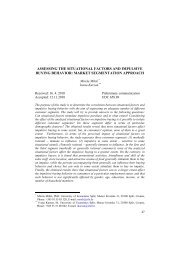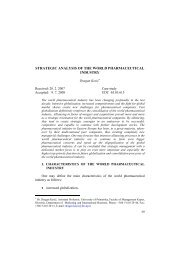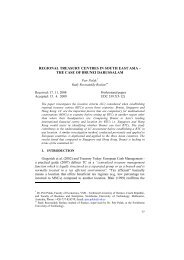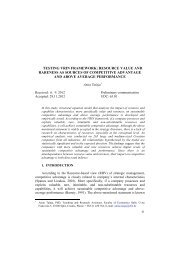the impact of the organisational structure and project organisational ...
the impact of the organisational structure and project organisational ...
the impact of the organisational structure and project organisational ...
You also want an ePaper? Increase the reach of your titles
YUMPU automatically turns print PDFs into web optimized ePapers that Google loves.
Management, Vol. 16, 2011, 2, pp. 1-22<br />
A. Stare: The <strong>impact</strong> <strong>of</strong> <strong>the</strong> organizational <strong>structure</strong> <strong>and</strong> <strong>project</strong> organizational culture…<br />
to learning from “pioneers”, <strong>the</strong>ir business solutions were significantly better,<br />
so <strong>the</strong>y forced <strong>the</strong> previously more successful competitors to change yet again.<br />
Everything has started to improve more rapidly (knowledge, research,<br />
technology, methodologies, tools, products, etc.). Thus, <strong>the</strong> growing quantity<br />
<strong>and</strong> variety <strong>of</strong> frequently changing factors in <strong>the</strong> environment are forcing<br />
enterprises into constant adaptation through self-modification. While <strong>project</strong>s<br />
have proven to be <strong>the</strong> most efficient way <strong>of</strong> making changes <strong>and</strong> for introducing<br />
innovations, <strong>the</strong> number <strong>of</strong> <strong>project</strong>s in enterprises is constantly rising.<br />
Unfortunately, many <strong>project</strong>s do not bring <strong>the</strong> benefits for which <strong>the</strong>y were<br />
implemented. Analyses <strong>of</strong> completed <strong>project</strong>s show that a significant number <strong>of</strong><br />
<strong>project</strong>s exceeds <strong>the</strong> planned time <strong>and</strong> costs, consequently reducing <strong>the</strong> benefits.<br />
Research conducted in 1998 by "The St<strong>and</strong>ish Group" showed that only 26<br />
percent <strong>of</strong> <strong>the</strong> <strong>project</strong>s initiated were completed successfully 1 . According to<br />
Jones (White, 2006), <strong>the</strong>re is only a 65% chance that an IT <strong>project</strong> will meet <strong>the</strong><br />
<strong>project</strong> participants’ expectations, while Burke (2003) states that just 18% <strong>of</strong> IT<br />
<strong>project</strong>s are executed within budget, 50% <strong>of</strong> <strong>the</strong>m exceeded <strong>the</strong> planned costs,<br />
while 30% <strong>of</strong> <strong>the</strong> <strong>project</strong>s are so expensive that <strong>the</strong>y are cancelled before<br />
completion. Authors indicate many causes <strong>of</strong> <strong>project</strong> failure, such as a poor<br />
definition <strong>of</strong> <strong>the</strong> objectives, an inadequate <strong>project</strong> schedule, too much<br />
uncontrolled change, insufficient control, a lack <strong>of</strong> resources, ineffective<br />
communication, an unclear role <strong>of</strong> <strong>the</strong> participants, a lack <strong>of</strong> top management<br />
support, too many teams focussing on technical solutions <strong>and</strong> neglecting <strong>the</strong><br />
people (customer, user), etc. (Young, 2000; Andersen et al., 2004; White, 2006;<br />
The St<strong>and</strong>ish Group in Young & Jordan, 2008).<br />
In addition, <strong>the</strong> strong rise in <strong>the</strong> number <strong>of</strong> <strong>project</strong>s requires ever more<br />
employees to become involved, thus increasing <strong>the</strong> number <strong>of</strong> different<br />
relationships <strong>and</strong> frequency <strong>of</strong> contacts. The collaboration <strong>of</strong> <strong>project</strong><br />
stakeholders basically represents a disturbance to regular work <strong>and</strong> <strong>the</strong>refore<br />
leads to short tempers <strong>and</strong> <strong>the</strong> dislike <strong>of</strong> such <strong>project</strong>s by line (functional)<br />
managers. If <strong>the</strong> roles, responsibilities, competencies <strong>and</strong> relationships between<br />
<strong>project</strong> stakeholders are not properly defined <strong>and</strong> carried into effect, even more<br />
conflicts could arise, resulting in less efficient <strong>project</strong> execution.<br />
Slovenian enterprises have had to introduce a much bigger number <strong>of</strong><br />
changes in <strong>the</strong> last 20 years because up until <strong>the</strong> 1990s, <strong>the</strong>y had fewer<br />
competitors <strong>and</strong> could even survive with less efficient operation <strong>and</strong> relatively<br />
obsolete products. Due to <strong>the</strong> mentioned weaknesses <strong>and</strong> less well-organised<br />
1 http://www.pmmaturity.com<br />
2

















